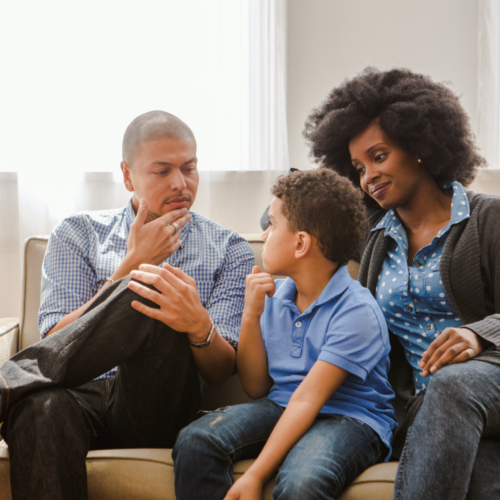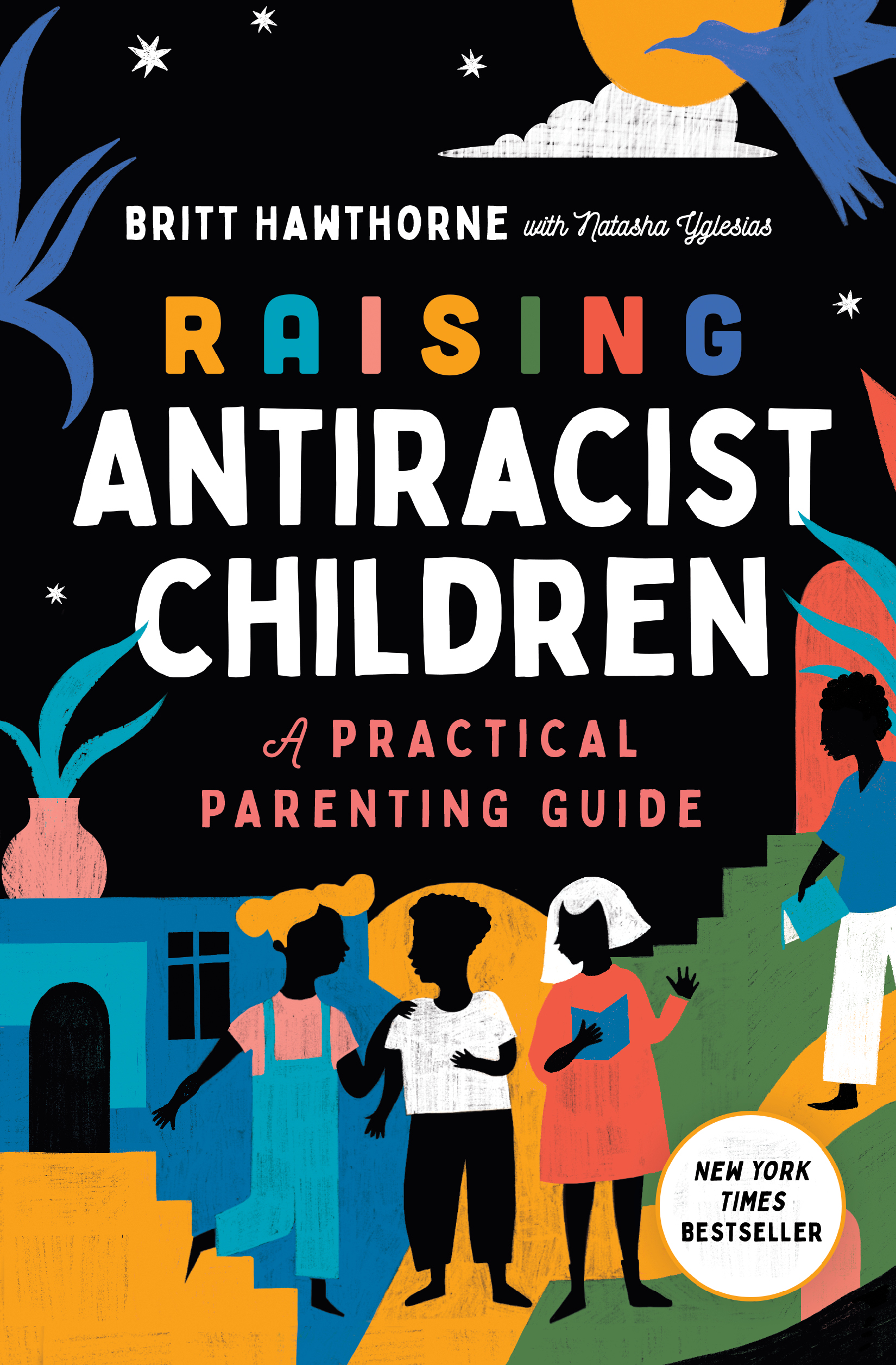When our kids begin to notice the world around them—with all its flaws and inequities—how do we guide them to better understand it without reinforcing harmful narratives? Our children ask us questions all day long, and it’s okay to not always know exactly what to say. Here is a guide on how to talk about houselessness with children.
When Our Children Ask: “Why Do Those People Live Under a Bridge?”
Questions like these always force me to reparent myself. I have to think about what I was taught, what I agree with, and what I still have left to learn and understand. This guide is a starting point for you and your family to begin the process of unpacking houselessness with your children.
1. We Respond
When our children ask about houselessness, our first step is to respond. It’s best to engage in the conversation with your child, instead of tabling it for a day when you feel more ready, or when they are older. Your child’s curiosity tells you that they’re ready to learn.
Here are some ways you can begin the conversation:
- “Remember when we had to move because the landlord increased the rent? Gentrification can cause people to lose their homes.”
- “Because our city doesn’t invest enough in affordable housing, people have to make difficult choices.”
- “It’s not just one thing. There are several reasons why people don’t have shelter. People are doing the best they can and they need more resources from our city.”
- “Housing costs are just too high in _______ (city), even for people working full-time.”
- “Our city/state doesn’t require a livable wage so people have tough choices to make. To put another way, being paid insufficiently directly leads to houselessness.”
- “Some people, especially women and adolescents, leave their home because it’s not safe. There is someone that is hurting them. If there isn’t a loved one or shelter that can offer them a place to stay, they live here.”
Draw From a Previous Experience
In these examples, we draw from a previous shared experience (that of moving homes due to rising rent). This can help your child avoid the “othering” that many create between those who are experiencing houselessness and those who are not.
Focus on Systemic Problems
If your family hasn’t experienced a similar situation, you can focus on the systemic state- and city-level problems that make access to housing so difficult. The lack of a liveable wage and affordable housing, healthcare, and mental health services make it easier for people to end up in dire circumstances. For many people—most often, women—domestic violence makes living outside safer than at home with their abusers.
2. We Discuss The Need for Housing
The next step is to help our children understand why housing is so important for humans, and how secure shelter supports people in reaching their fullest potential.
You might be familiar with Maslow’s hierarchy of needs, which is based on indigenous wisdom from the Blackfeet Nation (yep, there’s archival evidence that he visited their sacred lands). In Maslow’s rendition, a human’s first needs are physiological—they need shelter and safety in order to build up to the other needs of belonging, love, esteem, and finally, self-actualization (later recorded as self-transcendence).
However, in the Blackfeet Nation’s hierarchy of needs, self-actualization is the first step on a journey to reach community actualization. A physiological need like housing is a result of self-actualization—people are self-actualized not because they have housing but because their community sees them as actualized beings entitled to basic needs. And, people have the propensity to actualize community when those needs are met.
“Self-actualization is at the base of the tipi, not at the top, and is the foundation on which community actualization is built. ” – Barbara Bray
Note: Since I am not a member, I welcome any feedback from the Blackfeet Nation. If I missed the mark on anything, please give me the opportunity to make it right.
Here are some reasons why people need homes that you can discuss with children:
Shelter Keeps Us Safe
The ability to lock one’s door at night creates the feeling and reality of safety, where one can rest their head on their pillow without the fear of being attacked, stolen from, or abused. When it rains, pours, or snows, our shelter keeps us safe from the elements, dry, and less likely to succumb to illness due to experiencing extreme weather.
Housing Protects Our Things
Housing gives people the chance to protect the personal possessions they love. As we acquire our favorite books, paintings, posters, and coffee mugs, our houses keep them safe. Everyone deserves to cherish the things they own, the things that contribute to their sense of personal style or identity.
Shelter Helps Us Relax
We need to rest in order to show up the next day with energy and motivation. Without the ability to truly relax, people are unable to unwind, and show up fatigued, distracted, unfocused, and unable to apply themselves in the ways they need to be the best version of themselves.
They Are Human Beings
All human beings are worthy of secure shelter. Period.
White supremacy and western indoctrination teach us that people “deserve” homes because they work hard, earned it, or need protection. And, the unearned privilege of whiteness or upper class prevents us from questioning this narrative. It is time to flip the script: every single person is worthy and deserving of housing.
3. We Act Justly as a Family
Last but not least, we are moving to action as a family. We think creatively about what we can do with our current resources and what our city can do to support people without houses. Houselessness is a big, worldwide problem—but it’s also a small, local one. There are ways for you and your family to get involved in improving the lives of others in your community.
Here are a few policies we support and actions we take as a family:
- Levy a tax on absentee owners to redirect funds to support affordable housing
- Support price-capped homes and community land trust programs
- Build micro-home communities
- We donate household supplies to local organizations
- We write letters to our local council members demanding more affordable housing
- We support a livable wage and support businesses that pay living wages
- We support down-payment programs
Going Further: Discussing the Issues and Solutions
Now that you have responded to your child, discussed the right to housing, and acted justly as a family—you can take a break. Amazing job! You just set up your little one with an empathetic framework to understand those who are living without shelter.
The next time houselessness comes up, you can begin a more in-depth conversation about the issues and solutions to the housing crisis.
Change the Language
By equipping our children with accurate language that offers people dignity and their community respect while holding systems accountable, we set them up for an unbiased understanding of houselessness.
Here are some simple language swaps your family can make:
- Instead of “low-income housing,” say “affordable housing”
- Instead of “handouts,” say “resources”
- Instead of “run-down neighborhood,” say “neglected neighborhood”
- Instead of “homeless people,” say “people experiencing homelessness,” “people without shelter,” “people without permanent shelter,” “our neighbors without houses right now” (thank you @nanaroyale59 on Instagram for the suggestion).
Using the term “houselessness” instead of “homelessness” can help restore dignity to those without shelter. Calling someone “homeless” implies that they do not have a home. But a home is so much more than a roof over one’s head. It’s community, it’s belonging, it’s a feeling. People experiencing houselessness can still create a home while they are navigating temporary or chronic houselessness.
Decenter Personal Responsibility
One of the most prevalent toxic narratives encircling houselessness is the myth of personal responsibility. That narrative tells us that people without shelter are there due to their own poor decisions.
Our housing market is a system—a well-oiled machine created to build wealth, and benefit certain groups of people while disenfranchising others. Our housing crisis isn’t about a few people making “poor choices.” Credit, income, wealth, education, and access all determine who is eligible to buy a home or rent a house.
In order to decenter personal responsibility from the narrative around houselessness, invite conversations about the following topics in your home:
- Income inequality
- Education inequality
- Racial inequality
- No access to affordable housing
- No health care
- Lack of mental health services
- Domestic violence
This is about creating a just society, where everyone who desires shelter has access to it, without barriers.
Read Books on Houselessness
Here are two books I recommend to deepen your understanding of houselessness in America.
1. Why We Live Where We Live by Kira Vermond and Julie McLaughlin
I highly recommend starting the conversation using this book because it introduces the why behind housing. This book helps elementary-aged children understand the complex topic of housing in a developmentally appropriate way. The book offers global examples and anecdotes, and it does a good job of introducing history and geography in a supportive way.
2. On Our Street: Our First Talk about Poverty by Jillian Roberts, Jaime Casap, and Jane Heinrichs
I recommend this book because it uses real pictures and first-person language! It’s an honest and balanced book that shows poverty and homelessness across the globe. Lastly, there are some great direct actions that are listed at the back of the book.
Reparenting Ourselves
As I reparent myself to unlearn the capitalistic ideas of real estate and to unlearn that housing is an individual’s problem, I wanted to share what I’ve learned and what I teach my children. I hope you have found this resource helpful! I plan to write more about this in the future and share additional resources. If that’s something you’re interested in having, please subscribe to my receive updates at britthawthorne.com. Learn more about me and explore resources for parents and educators.





